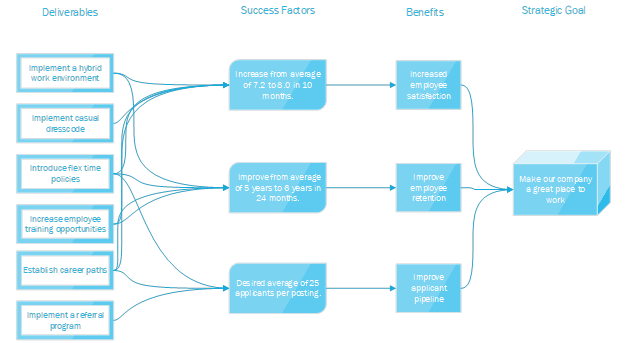By Cynthia Snyder Dionisio
June 14, 2023
These days there is a lot of focus on value delivery and benefits management. As project managers we need to be able to describe the value proposition of a project in terms of the business benefits the project will create for stakeholders and the organization. Benefits can be quantitative, such as financial metrics, or qualitative such as customer retention or improved employee morale. Whether quantitative or qualitative, benefits are the outcomes of a project that provide value to the organization in return for the investment made in the project.
Benefits management is about realizing the business results from the investment in a project. An important aspect of benefits management is a benefits map. A benefits map charts the path from business strategy to benefits delivery. It provides traceability from project deliverables to the intended benefits. This information feeds into the project vision and scope and allows the project manager to track the benefits delivery throughout the project, and in some cases, beyond.
Steps to Create a Benefits Map
There are five steps to create a Benefits Map.
- Define the strategic business goals the project will address. These can be either organization strategic goals, or business unit strategic goals.
- Define success factors. Success factors describe how success is defined and how it will be measured. Success factors should be measurable where possible and three to six factors are a good number. If it is more than that, there’s a chance the team’s focus gets diluted.
- Identify the deliverables that will be used to achieve the success factors. Deliverables can be identified by creating a high-level WBS where the deliverables at Level 2 or 3 represent the key deliverables that will meet the success criteria and achieve the expected benefits.
- Map the deliverables to the benefits. Create a graphic that shows the relationship between project deliverables, success factors, and business goals.
- Validate the benefits map. Ensure that all business goals are addressed and that all deliverables contribute to one or more business goals.
This is an example of a benefits map for a project that will contribute to the strategic goal of making the organization a great place to work. You can see the benefits that map to the goal, the success factors that quantify the benefits, and the deliverables that are designed to achieve the success factors and the benefits.

A benefits map helps the project team understand how their project directly contributes to the organization. This can provide a structure to make decisions on the project by keeping the success factors and benefits top of mind. It helps senior management track how projects are contributing to the strategic goals and provides a way of measuring the progress towards benefit realization. Finally, it provides a way to demonstrate the success of a project from the perspective of value delivery and benefits realization.
About the Author
Cynthia Snyder Dionisio is the Practice Lead for IIL’s Project, Program, and Portfolio Management (PPPM) Practice. Cyndi has over 20 years of experience leading international project teams, consulting, developing courses, and facilitating training. She has received several awards, including the PMI Fellow Award in 2018 and PMI’s Distinguished Contribution Award in 2009. Cyndi is passionate about turning chaos in order, engaging with awesome teams, solving problems, and facilitating achievement.
Disclaimer: The ideas, views, and opinions expressed in this article are those of the author and do not necessarily reflect the views of International Institute for Learning or any entities they represent.



